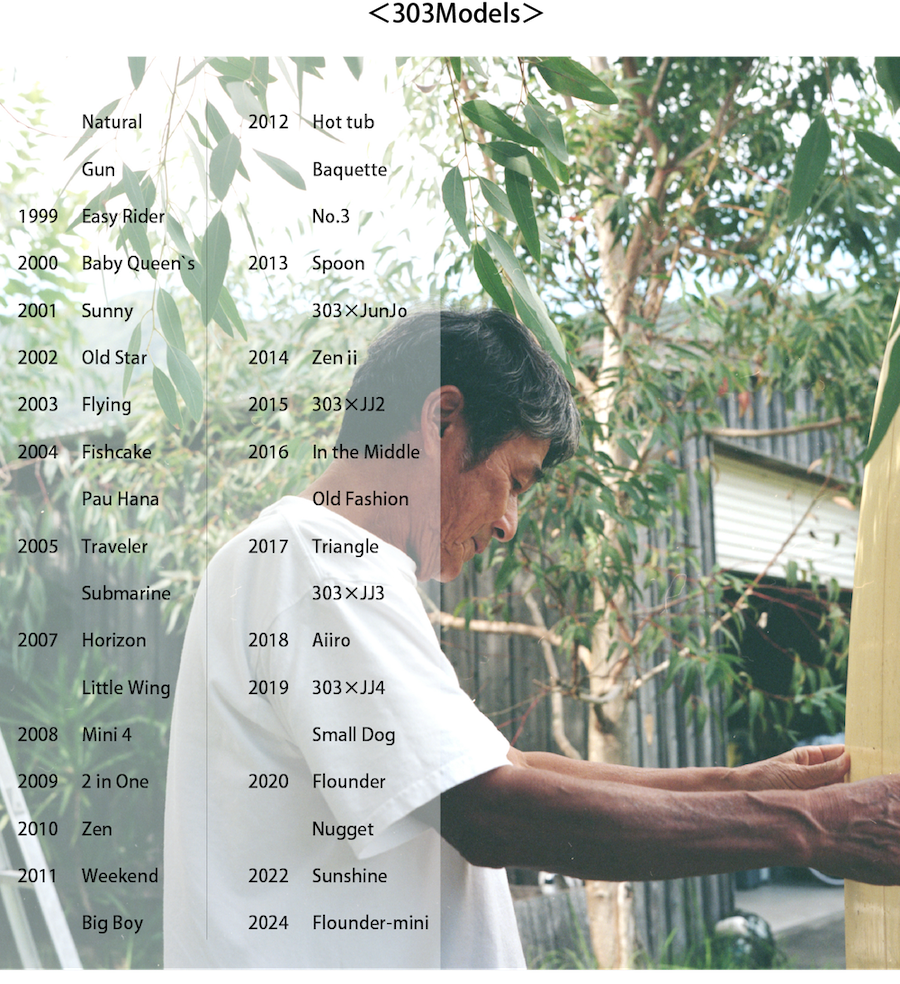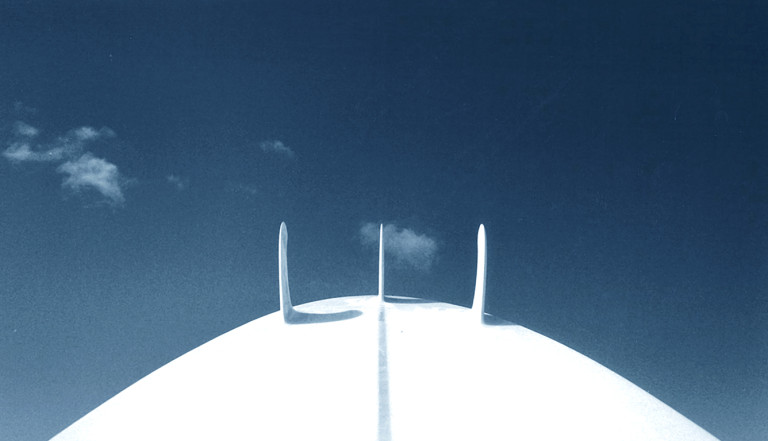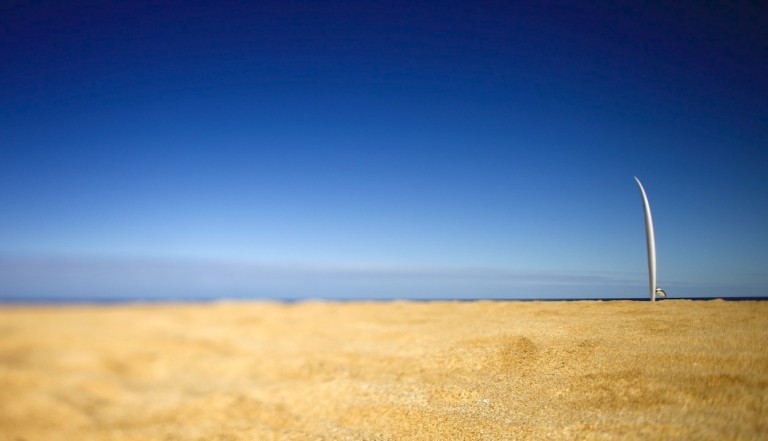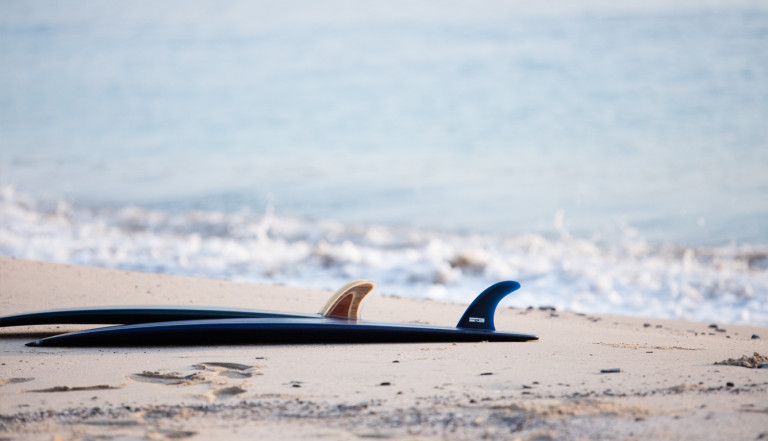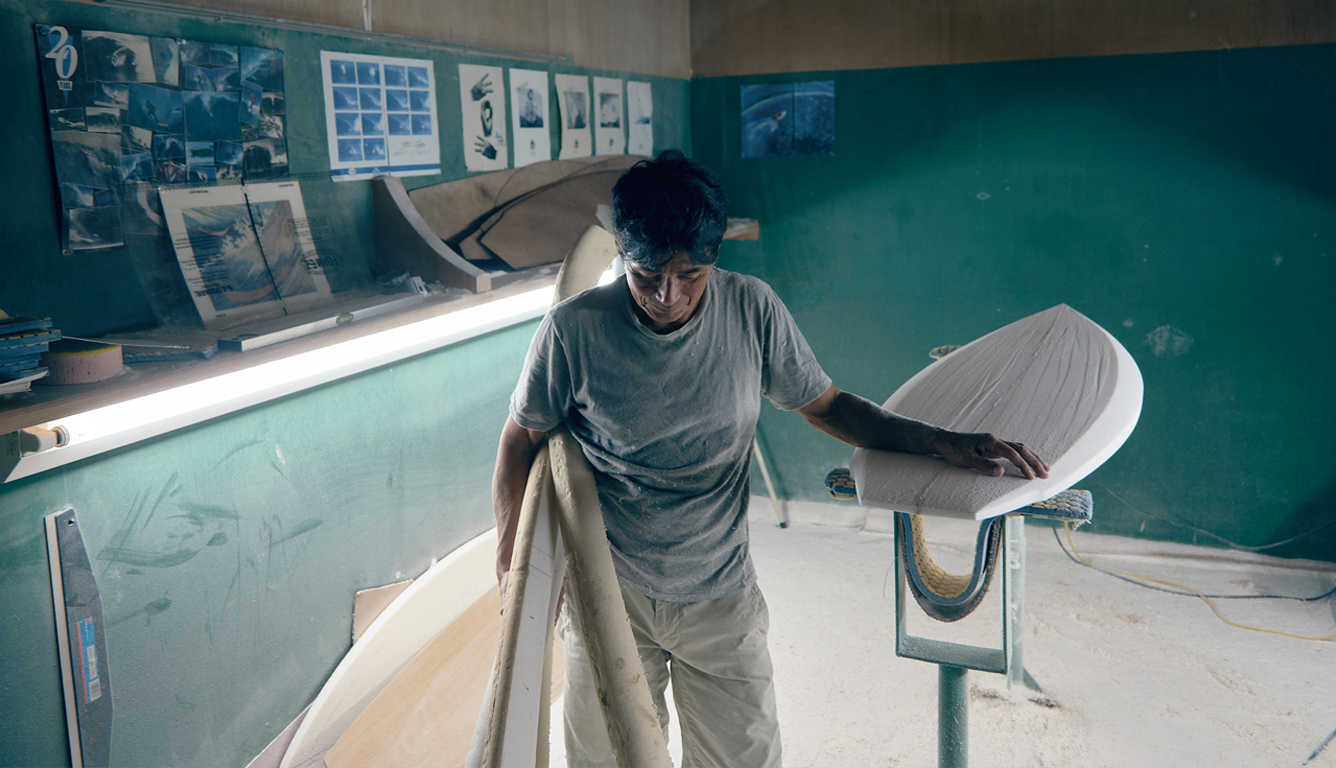
Feature 008
IMAGINATION ROOM
The place where surfboards are born
Text by Three O Three
Photography by Keisuke Fukamizu
Photography by Keisuke Fukamizu
Feature 008 | IMAGINATION ROOM |
Text by Three O Three
Photography by Keisuke Fukamizu
Photography by Keisuke Fukamizu
The place where surfboards are born
サーファーの工房
工房は海から少し下った小さな漁師町の片隅にありました。大きなスレートの引き戸を引くと、まず目を引くのは303のいろいろな形のサーフボードたち。その向こうにはショートからロングまでの無垢なサーフボードブランクスが順序良く並んでいました。車が4台ぐらいは楽に入る倉庫の中には他に、作業台やウエットスーツラック、誰かと談笑できる木造りのテーブルや椅子、ハンモック、作業着用の洗濯機と古いリーシュコードで作られた物干し。おそらく自分にとってはスペシャルを並べた小型のサーフボードラック。壁に貼られた写真家ブルース・ウェーバーのポスターは印象的で、波だけの写真や毎年向かうハワイから持ち帰った『Eddie Would Go』のポスターもありました。サーフボードラックの横をふと見ると、海に潜る足ヒレや魚を突くモリや獲物用の網袋。椅子に座ると大きな窓から引き戸へと抜ける風が心地よく、テーブルの上に乗ったガラスの浮き玉やビーチグラスはキラキラと輝き、ほかにサーフィン雑誌やアメリカやイタリアのファッション雑誌、仕事をするときにかけるカセットテープ、フィンやワックスが数個。それらにふんわりとブランクスの粉が舞い降りていました。
そんなアプローチ横に造作されていたのがサーフボードのシェイピングルームでした。公平さんが誰にも明かさず、ハワイで習い、目で学び、日本で何百本もプレーナーワークを練習した末に手に入れた大切なその空間は、サーフィンをしている地元の大工さんが丁寧に作ってくれたといいます。外壁のむき出しの木材が雰囲気のある部屋への扉には、歴史を感じるステッカーやプロサーファーたちが描いたサインのチューン。アプローチに居ても聞こえるプレーナーの音がやんだタイミングで、子供から大人までどれだけのサーファーがこの扉をノックしたことでしょうか。
扉を開けると、国内外のシェイピングルームのスタンダードよりはるかにゆとりを感じる空間が広がり、クリアーな蛍光灯がシェイプされたばかりのブランクスの形を鮮明に映し出ていました。足を踏み入れると真白なブランクスの粉がまるで絨毯のよう。今ではBluetoothで飛ばす音楽は小さなカセットデッキから。作業台に置かれた工具たちは生き生きと。プレーナーはもちろんアメリカ製の『SKILL 100 PLANE』で、ノコギリも『STANLEY』。ペーパーもスポンジもブロックもハワイへ行くたびに立ち寄る『FIBERGLASS HAWAII』で買ってきたものでした。日本のしきたりは“引き”ノコギリですが、海の中では引く(控える)心を大切にしている日本人サーファーが、ブランクスの余分なレールをアメリカ製の“押し“ノコギリで切り落とす力強い姿に、サーフィンの生い立ちが日本ではないことをあらためて教えられているようでした。
Surfer's Workshop
The workshop was located in a corner of a small fishing town, a short distance down from the sea. When you pulled open the large slate sliding door, the first thing that caught your eye was the 303 surfboards of various shapes and sizes. Beyond them were immaculate surfboard blanks, from short to long, lined up in order. Inside the warehouse, which large enough that could easily fit four cars, there were also workbenches, wetsuit racks, a wooden table and chairs for chatting with someone, a hammock, a washing machine for work clothes and a clothesline made of broken leash cords. Perhaps a small surfboard rack lined with specials a.k.a Magic Boards.
The posters of photographer Bruce Weber on the walls were impressive, some just of waves, others of "Eddie Would Go" for the event that he brought back from Hawaii, where he visited every year.
A quick glance next to the surfboard rack showed fins for diving in the ocean, harpoons for fishing, and net bags. Sitting in a chair, the breeze through the large window to the sliding door was pleasant, glass floats and beach glass on the table sparkled, and there were surfing magazines, American and Italian fashion magazines, a cassette tape to put on while working, a few fins and wax, and a few pieces of wax. There was a fluffy dusting of blanks on them.
Built next to the approach was a surfboard shaping room. Kohei did not reveal it to anyone at the time, but he learned it in Hawaii, studied it with his own eyes, and practiced planer work on hundreds of boards in Japan, before acquiring this precious space. It was carefully built by a local carpenter who surfs. The exposed wood of the exterior wall is atmospheric, and the door to the room is tuned with historical stickers and signs drawn by visiting surfers & friends. How many surfers, both children and adults, must have knocked on this door just as the planer noise ceased? ( Sign of Kohei finishing up)
When we opened the door, the space felt much more spacious than the standard shaping rooms in Japan and even abroad, and the clear fluorescent lights clearly reflected the shapes of the freshly shaped blanks. Stepping into the room, the pure white powder of the blanks looked like a carpet. The music now played via Bluetooth came from a small cassette player. The tools on the workbench are clean and lively. The planer is of course "SKILL 100 PLANE" made in the U.S., and the saw is "STANLEY” also USA product. The sandpaper, sponges, and blocks were all bought at FIBERGLASS HAWAII, a place he stop by every time he visit Hawaii. The Japanese tradition is to use a "pull" saw, but a Japanese surfer, who values a "pull" (refrain) mind in the ocean, used an American-made "push" saw to cut off the extra rail of the blanks. The powerful figure cutting off the excess rail of the blanks with an American-made "push" saw seemed to teach us once again that surfing does not originate in Japan.
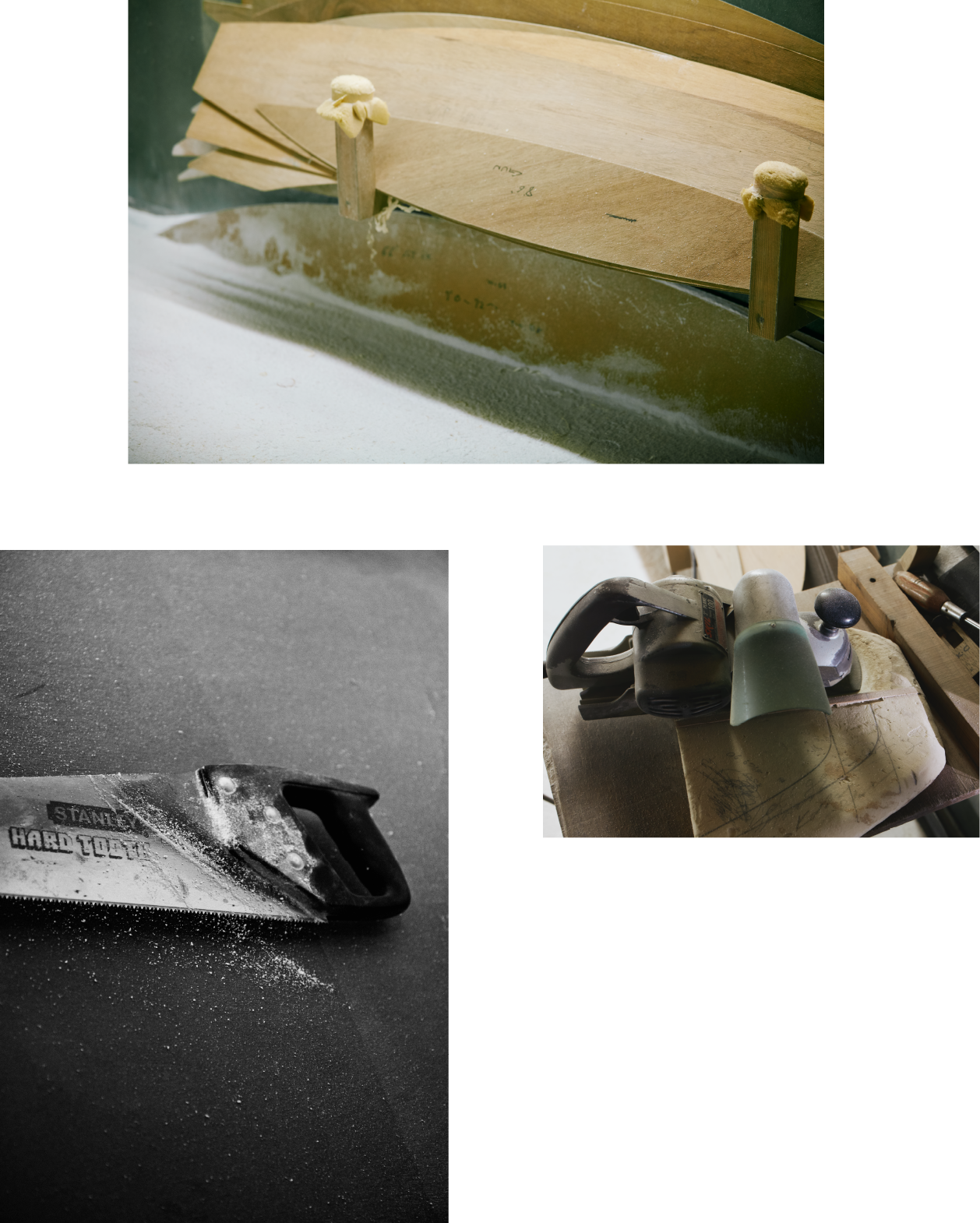
心で乗り、心で作る
シェイピングルームの壁には作業するのに邪魔にならない高さを保って、ハワイでクリエイトした303の広告ページや、長きにわたって303のユーザーへ送っていたオリジナルのバースデーカードが数枚。旅に出て撮影された自分や愛弟子たちのサーフィンショットのスクラップがギャラリーのように並んでいました。ノースショアのパイプラインやバックドア、サンセット。インドネシアのグラジガン、美しいタヒチ、ヨーロッパ、四国での永遠に残るベストショット。とびきりの笑顔。旅を続け、自分のサーフィンを磨き、ウインターシーズンのノースショアでは日本人サーファーのマエストロとして歩んできたサーファーとしての軌跡。もちろんその波に乗ったのは、この部屋で経験とイマジネーションから削られたサーフボードであり、作り手であり乗り手である公平さんの「日本人の中にあって数少ない、ハートで波に乗るサーファー」と語られるゆえんが見え隠れしていました。その中にあるアメリカのフォトグラファーが撮影した90年代のパイプラインの見開き記事に、こんな自身のコメントがありました。
「日本からも近いし、21歳からずっと来ています。ノースショアほど大きい波というのは他にはそうそう無いし、だからここで1〜2ヶ月サーフィンしたら、次にどこかへ行くときにはとても楽です。波の慣れという面で。ハワイは混んでいるけれどもどこでも波はあるし、長いボードを使うところから入るでしょ。他のところだったらそのまま行けてしまうけど、まずここは長いボードのコントロールが覚えられる。なかなか慣れないし難しいけれど、長いボードをコントロールする楽しさが出てくるしね。といっても自分の場合は、パイプラインのあのエリアで一番大きい時でも7’2”くらいまでかな。だから他のサーファーに比べると短いボードを使っています。長いボードだと引っかかるしもたつくから。波はツルッとしていて綺麗で、チューブの中も走りやすい。短いボードでもテイクオフさえメイクしてしまえば、その方が乗っていて楽ですからね。それも人の好き好きで、いいとかダメだとかは無いです。昔は8ft.のパイプラインでも、178cmのボードで乗っていたこともありましたから。笑

少し前から考えていたのは、今回のハワイではもっと長い波に乗りたいなっていうこと。サンセットやパイプが良かったりしても、そういうところを逆にはずして小さくても長くて綺麗な、そんな波に乗れるように心がけているかな。攻めなきゃいけないっていう日は絶対にありますけど、そうじゃ無いサーフィンもありますから。
サーフボードは今回、短いものは自分でシェイプしたものを持ってきて、あとはこっちで他のシェイパーのボードも乗ってみます。あんまり流行に左右されるのは良くないけど、人のシェイプも参考にして研究して、帰ってから良かったっていう部分をとり入れて。サーフィンにもシェイプにも上には上がいますから。ハワイだけでなく、行けるときにはできるだけ色々なところへ行って学んでいきたいと思います」
スラスター全盛期の‘80〜’90年代を経て、ウインターシーズンのノースショア滞在は、その後2011年まで続きました。2000年代になると303のサーフボードデザインは多様化していき、波の大きさによって長さが変化するスラスターやガンだけでないモデルを持ってハワイへ向かう公平さんの姿がありました。サーフィンする楽しさを叶えてくれる道具、サーフボードを作り、いろいろな波へ向かい、ただ向かうのでなく感じ、学び、工夫し、また向かう。旅に出ること、波に乗ることで蓄積されていく目には見えない感覚をシェイピングルームで試行錯誤の末に形にし、熟成させて、現在まで303は36のモデルを誕生させました。
2017年3月。道を下った漁師町にある愛おしい工房は、道路拡張工事のために解体されることになりました。惜別の想いは303チームの誰にもありましたが、公平さんがオーストラリアへサーフトリップに出かけている間に、大きなトラック一杯分の思い出が持ち去られ、がらんとした空間にはけれど同じ窓から引き戸への爽やかな風が抜けて、背中を押されるように新しい工房でのサーフボード作りがスムーズにスタートしていきました。
Ride with your heart, create with your mind
On the walls of the shaping room, kept high out of the way for working, are a few 303 ad pages created in Hawaii and a few original birthday cards that were sent to long-time 303 users. A gallery of scraps of surfing shots of himself and his protégés taken on the trip were lined up like a gallery. Pipeline, Backdoor, and Sunset on the North Shore. Gurajigan, Indonesia. Beautiful Tahiti, Europe, and the best shots that will last forever in Shikoku. The most amazing smiles. A surfer's path who has continued to travel, hone his surfing, and become a maestro of Japanese surfers on the North Shore during the winter season. Of course, the surfboards he rode on those waves were sharpened from his experience and imagination in this room, revealing the reason why he is called "one of the few Japanese surfers who ride waves with their hearts.”
There was an article of 90’s magazine spread on Pipeline taken by an American photographer, in which he commented as follows.
“It is close to Japan and I have been coming here since I was 21 years old. There are not many waves as big as the North Shore, so after surfing here for a month or two, it is very easy to go somewhere else next time, in terms of wave familiarity. In Hawaii, it's crowded, but there are waves everywhere, and you start with a longer board. In other places, you can go straight to the surf, but here you learn to control a longer board first. It's hard to get used to and it's difficult, but it's fun to control a longer & heavier board. But for me, the biggest board for Pipeline is 7'2". So, I guess I use shorter boards than other surfers. Longer boards get stuck and slow down easily. The waves are smooth and clean, and it's easy to ride in the tubes. If I can make takeoffs with a shorter board, the rest easier. It's also a matter of what people like, and there is no good or bad. I used to ride the 8ft. Pipeline with a 178cm board. ( Laugh) I have been thinking for a while now that I want to ride longer waves this time in Hawaii. Even if Sunset or Pipe are good, I try to ride small but long and beautiful waves. There are definitely,THE DAY, when you have to go for it, but there are also days when you don't have to.
For surfboards this time, I will bring my own shortboards that I shaped myself, and I will also ride other shapers' boards here. It is not good to be influenced by the latest trends, but I will study the shapes of others and incorporate what I find good after I return home. There is always someone better at surfing and shaping. I want to learn not only in Hawaii, but also in as many other places as I can when I can.”
After the heyday of thrusters in the '80s and '90s, his stay on the North Shore during the winter season continued until 2011. 303 surfboard designs became more diverse in the 2000s, with not only thrusters and guns that change length depending on the size of the wave, but also a variety of other types of surfboards. In the 2000s, 303 surfboard designs diversified, and Kohei headed to Hawaii with a model that was not only a thruster or gun that changed length depending on the size of the wave. He made surfboards, the tools that make surfing fun, and headed out to various waves, not just to surf, but to feel, learn, devise, and surf again. The invisible sensations that accumulate from traveling and riding waves are shaped and matured in the shaping room through trial and error, and to date, 303 have created 36 models.
March 2017. The beloved workshop, located in a fishing town down the road, was to be demolished for road expansion. Everyone on the 303 team had fond memories of the loss, but while Kohei-san was away on a surf trip to Australia, a truckload of memories were taken out and moved to new location, and a fresh breeze blew through the same windows and sliding doors in the empty space.
The surfboard making in the new workshop started smoothly right after that.
